Double Overt-Leaf Shaped CPW-Fed Four Port UWB MIMO Antenna
Abstract
:1. Introduction
2. Single Element Design
2.1. Parametric Study
2.2. Simulation Results
3. Proposed MIMO Antenna
3.1. 2 × 2 MIMO Array
3.2. Proposed 4 × 4 MIMO Array
Fabrication and Measurements
4. Assesment of MIMO Performance Parameters
4.1. Envelope Correlation Coefficient
4.2. Diversity Gain
4.3. Mean Effective Gain
4.4. Channel Capacity
5. Conclusion
Author Contributions
Funding
Institutional Review Board Statement
Informed Consent Statement
Data Availability Statement
Acknowledgments
Conflicts of Interest
References
- Tripathi, S.; Mohan, A.; Yadav, S. A compact Koch fractal UWB MIMO antenna with WLAN band-rejection. IEEE Antennas Wirel. Propag. Lett. 2015, 14, 1565–1568. [Google Scholar] [CrossRef]
- Khan, M.S.; Capobianco, A.D.; Asif, S.M.; Anagnostou, D.E.; Shubair, R.M.; Braaten, B.D. A compact CSRR-enabled UWB diversity antenna. IEEE Antennas Wirel. Propag. Lett. 2016, 16, 808–812. [Google Scholar] [CrossRef]
- Iqbal, A.; Saraereh, O.A.; Ahmad, A.W.; Bashir, S. Mutual coupling reduction using F-shaped stubs in UWB-MIMO antenna. IEEE Access 2017, 6, 2755–2759. [Google Scholar] [CrossRef]
- Chandel, R.; Gautam, A.K.; Rambabu, K. Design and packaging of an eye-shaped multiple-input–multiple-output antenna with high isolation for wireless UWB applications. IEEE Trans. Components Packag. Manuf. Technol. 2018, 8, 635–642. [Google Scholar] [CrossRef]
- Chandel, R.; Gautam, A.K.; Rambabu, K. Tapered fed compact UWB MIMO-diversity antenna with dual band-notched characteristics. IEEE Trans. Antennas Propag. 2018, 66, 1677–1684. [Google Scholar] [CrossRef]
- Tang, Z.; Wu, X.; Zhan, J.; Hu, S.; Xi, Z.; Liu, Y. Compact UWB-MIMO antenna with high isolation and triple band-notched characteristics. IEEE Access 2019, 7, 19856–19865. [Google Scholar] [CrossRef]
- Dey, A.B.; Pattanayak, S.S.; Mitra, D.; Arif, W. Investigation and design of enhanced decoupled UWB MIMO antenna for wearable applications. Microw. Opt. Technol. Lett. 2020, 63, 845–861. [Google Scholar] [CrossRef]
- Bahmanzadeh, F.; Mohajeri, F. Simulation and fabrication of a high-isolation very compact MIMO antenna for ultra-wide band applications with dual band-notched characteristics. AEU-Int. J. Electron. Commun. 2021, 128, 153505. [Google Scholar] [CrossRef]
- Wu, W.; Yuan, B.; Wu, A. A quad-element UWB-MIMO antenna with band-notch and reduced mutual coupling based on EBG structures. Int. J. Antennas Propag. 2018, 2018, 8490740. [Google Scholar] [CrossRef] [Green Version]
- Naidu, P.R.T.; Saha, C.; Krishna, K.V.; Shaik, L.A.; Siddiqui, J.Y.; Antar, Y. Compact multiple EBG cells loaded UWB-narrowband antenna pair with high isolation for cognitive radio (CR) based MIMO applications. AEU-Int. J. Electron. Commun. 2020, 127, 153420. [Google Scholar] [CrossRef]
- Kumar, N.; Kiran, K.U. Meander-line electromagnetic bandgap structure for UWB MIMO antenna mutual coupling reduction in E-plane. AEU-Int. J. Electron. Commun. 2020, 127, 153423. [Google Scholar] [CrossRef]
- Modak, S.; Khan, T. A slotted UWB-MIMO antenna with quadruple band-notch characteristics using mushroom EBG structure. AEU-Int. J. Electron. Commun. 2021, 134, 153673. [Google Scholar] [CrossRef]
- Bilal, M.; Saleem, R.; Abbasi, H.H.; Shafique, M.F.; Brown, A.K. An FSS-based nonplanar quad-element UWB-MIMO antenna system. IEEE Antennas Wirel. Propag. Lett. 2016, 16, 987–990. [Google Scholar] [CrossRef]
- Rekha, V.S.D.; Pardhasaradhi, P.; Madhav, B.T.P.; Devi, Y.U. Dual Band Notched Orthogonal 4-Element MIMO Antenna with Isolation for UWB Applications. IEEE Access 2020, 8, 145871–145880. [Google Scholar] [CrossRef]
- Tiwari, R.N.; Singh, P.; Kanaujia, B.K. A compact UWB MIMO antenna with neutralization line for WLAN/ISM/mobile applications. Int. J. RF Microw. Comput.-Aided Eng. 2019, 29, e21907. [Google Scholar] [CrossRef]
- Kumar, S.; Lee, G.H.; Kim, D.H.; Mohyuddin, W.; Choi, H.C.; Kim, K.W. Multiple-input-multiple-output/diversity antenna with dual band-notched characteristics for ultra-wideband applications. Microw. Opt. Technol. Lett. 2020, 62, 336–345. [Google Scholar] [CrossRef]
- Ramanujam, P.; Venkatesan, P.R.; Arumugam, C.; Ponnusamy, M. Design of miniaturized super wideband printed monopole antenna operating from 0.7 to 18.5 GHz. AEU-Int. J. Electron. Commun. 2020, 123, 153273. [Google Scholar] [CrossRef]
- Khan, A.A.; Naqvi, S.A.; Khan, M.S.; Ijaz, B. Quad port miniaturized MIMO antenna for UWB 11 GHz and 13 GHz frequency bands. AEU-Int. J. Electron. Commun. 2021, 131, 153618. [Google Scholar] [CrossRef]
- Hasan, M.N.; Chu, S.; Bashir, S. A DGS monopole antenna loaded with U-shape stub for UWB MIMO applications. Microw. Opt. Technol. Lett. 2019, 61, 2141–2149. [Google Scholar] [CrossRef]
- Sohi, A.K.; Kaur, A. A complementary Sierpinski gasket fractal antenna array integrated with a complementary Archimedean defected ground structure for portable 4G/5G UWB MIMO communication devices. Microw. Opt. Technol. Lett. 2020, 62, 2595–2605. [Google Scholar] [CrossRef]
- Wang, E.; Wang, W.; Tan, X.; Wu, Y.; Gao, J.; Liu, Y. A UWB MIMO slot antenna using defected ground structures for high isolation. Int. J. RF Microw. Comput.-Aided Eng. 2020, 30, e22155. [Google Scholar] [CrossRef]
- Kumar, A.; Ansari, A.Q.; Kanaujia, B.K.; Kishor, J. A novel ITI-shaped isolation structure placed between two-port CPW-fed dual-band MIMO antenna for high isolation. AEU-Int. J. Electron. Commun. 2019, 104, 35–43. [Google Scholar] [CrossRef]
- Wang, L.; Du, Z.; Yang, H.; Ma, R.; Zhao, Y.; Cui, X.; Xi, X. Compact UWB MIMO antenna with high isolation using fence-type decoupling structure. IEEE Antennas Wirel. Propag. Lett. 2019, 18, 1641–1645. [Google Scholar] [CrossRef]
- Raheja, D.K.; Kanaujia, B.K.; Kumar, S. Compact four-port MIMO antenna on slotted-edge substrate with dual-band rejection characteristics. Int. J. RF Microw. Comput.-Aided Eng. 2019, 29, e21756. [Google Scholar] [CrossRef]
- Rafique, U.; Din, S.U.; Khalil, H. Compact CPW-fed Super Wideband Planar Elliptical Antenna. Int. J. Microw. Wirel. Technol. 2021, 13, 407–414. [Google Scholar] [CrossRef]
- Sharawi, M.S. Printed multi-band MIMO antenna systems and their performance metrics [wireless corner]. IEEE Antennas Propag. Mag. 2013, 55, 218–232. [Google Scholar] [CrossRef]
- Balanis, C.A. Antenna Theory: Analysis and Design; John Wiley & Sons: Hoboken, NJ, USA, 2015. [Google Scholar]
- Koohestani, M.; Moreira, A.A.; Skrivervik, A.K. A novel compact CPW-fed polarization diversity ultrawideband antenna. IEEE Antennas Wirel. Propag. Lett. 2014, 13, 563–566. [Google Scholar] [CrossRef]
- Rafique, U.; Agarwal, S.; Nauman, N.; Khalil, H.; Ullah, K. Inset-fed Planar Antenna Array for Dual-band 5G MIMO Applications. Prog. Electromagn. Res. C 2021, 112, 83–98. [Google Scholar] [CrossRef]
- Ullah, R.; Ullah, S.; Faisal, F.; Ullah, R.; Mabrouk, I.B.; Al Hasan, M.J.; Kamal, B. A novel multi-band and multi-generation (2G, 3G, 4G, and 5G) 9-elements MIMO antenna system for 5G smartphone applications. Wirel. Netw. 2021, 27, 4825–4837. [Google Scholar] [CrossRef]
- Abdullah, M.; Kiani, S.H.; Abdulrazak, L.F.; Iqbal, A.; Bashir, M.; Khan, S.; Kim, S. High-performance multiple-input multiple-output antenna system for 5G mobile terminals. Electronics 2019, 8, 1090. [Google Scholar] [CrossRef] [Green Version]
- Li, Y.; Zou, H.; Wang, M.; Peng, M.; Yang, G. Eight-element MIMO antenna array for 5G/Sub-6GHz indoor micro wireless access points. In Proceedings of the 2018 International Workshop on Antenna Technology (iWAT), Nanjing, China, 5–7 March 2018; pp. 1–4. [Google Scholar]

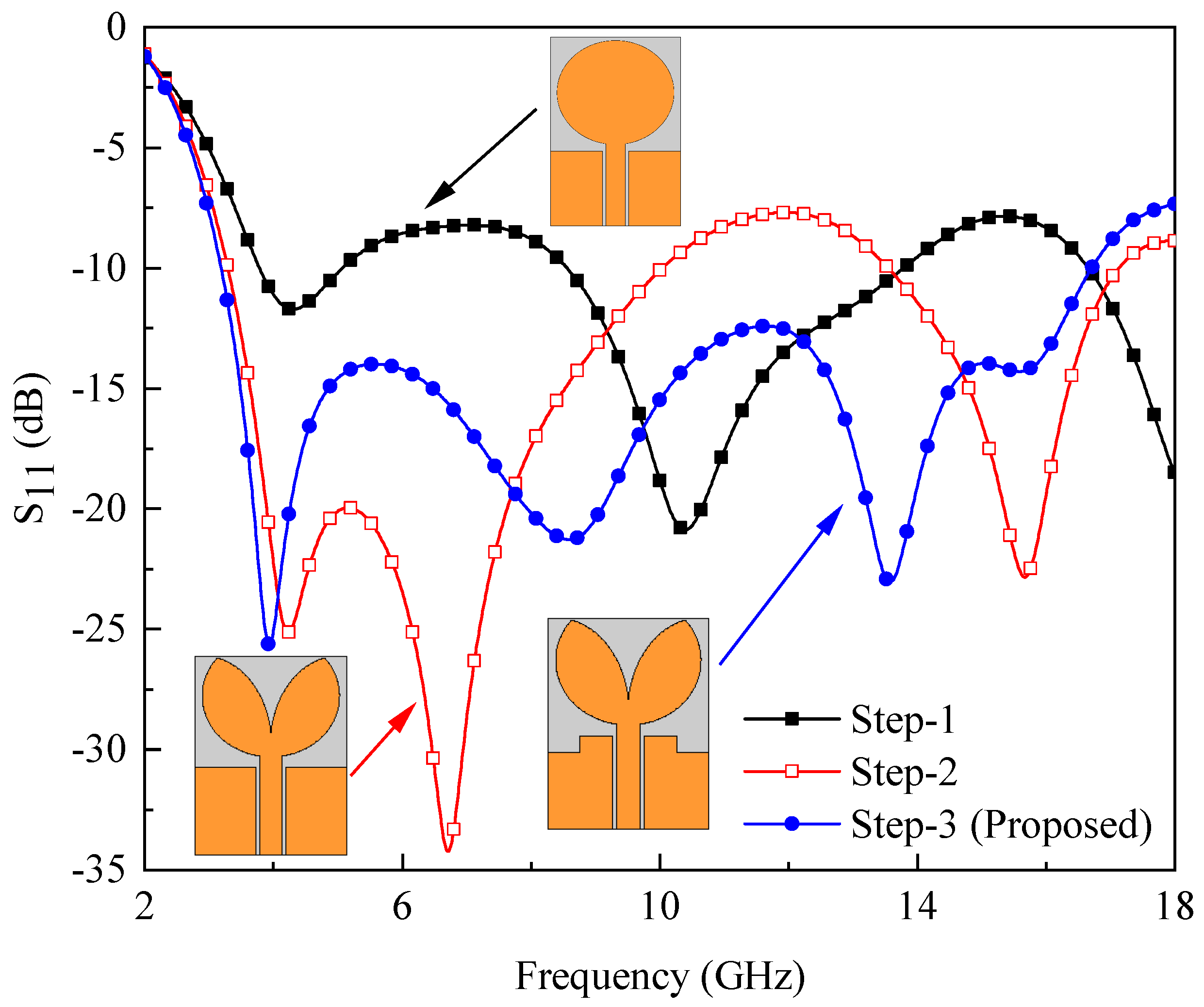
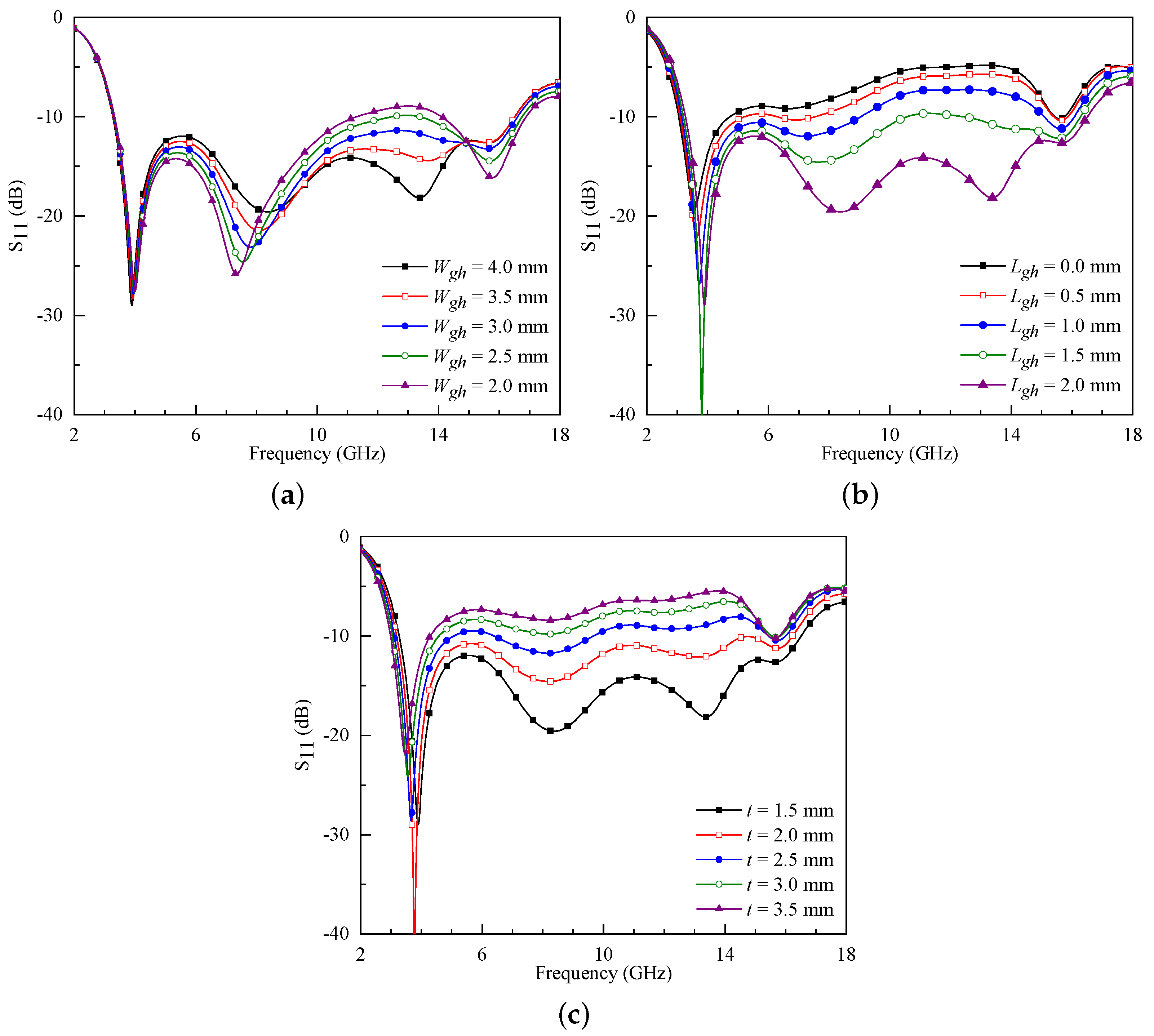
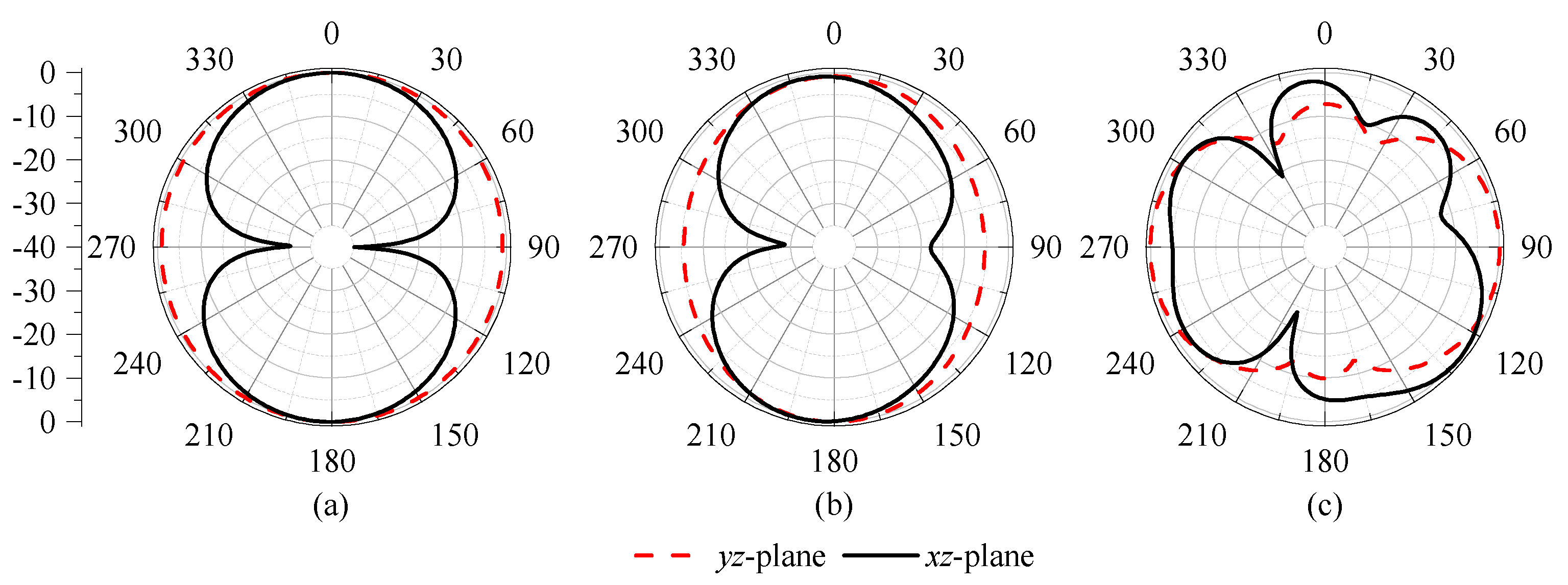
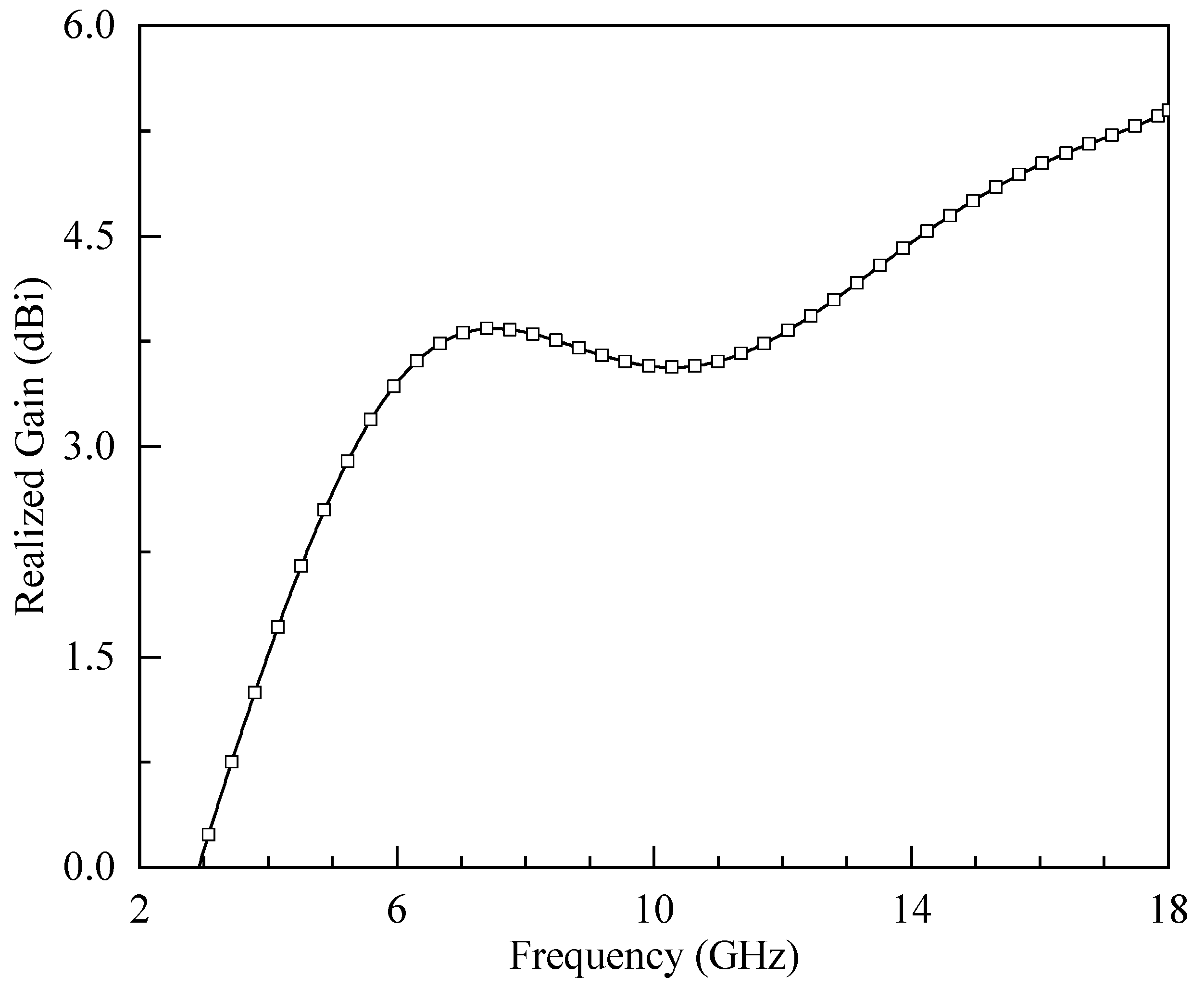
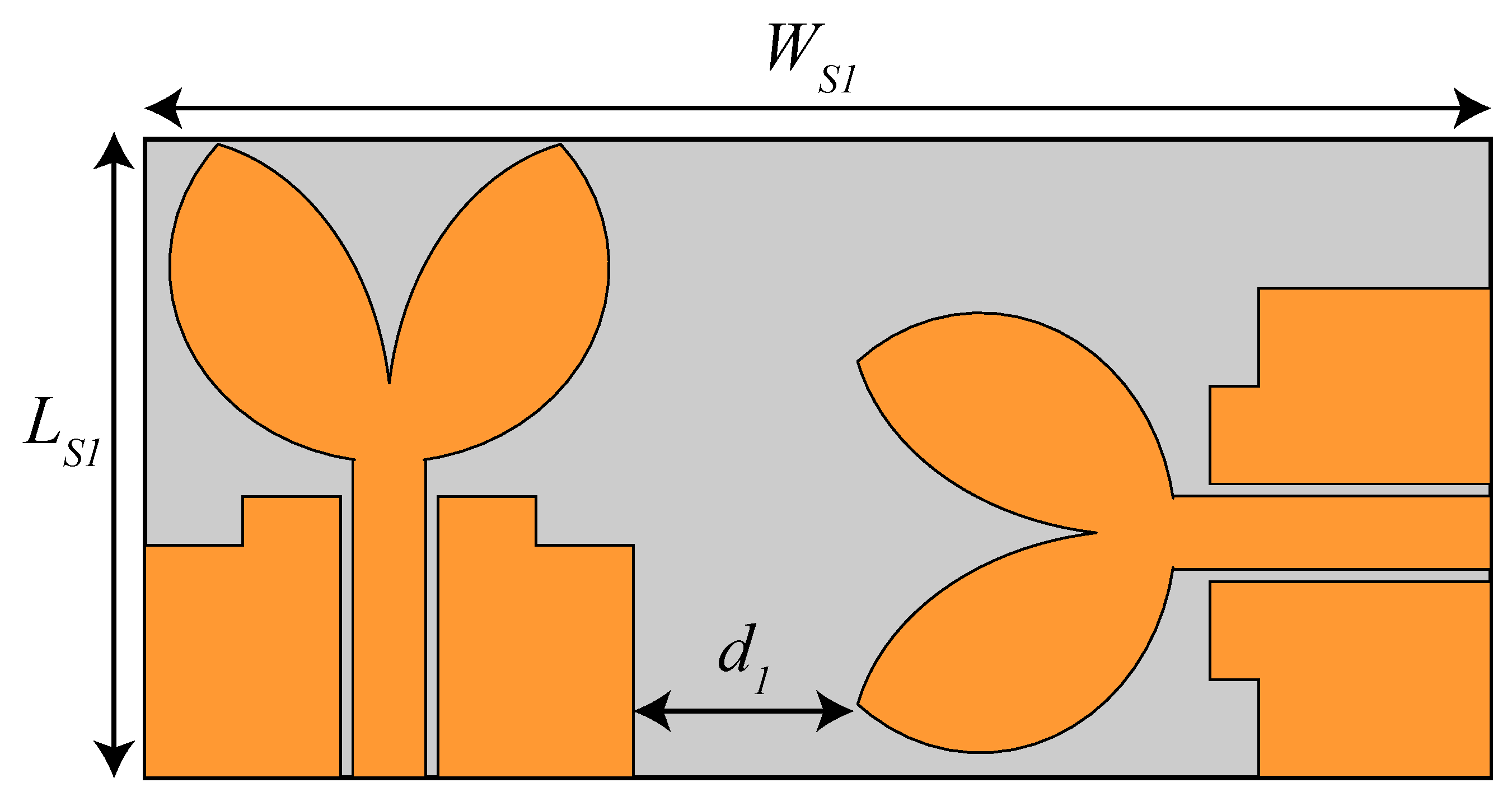
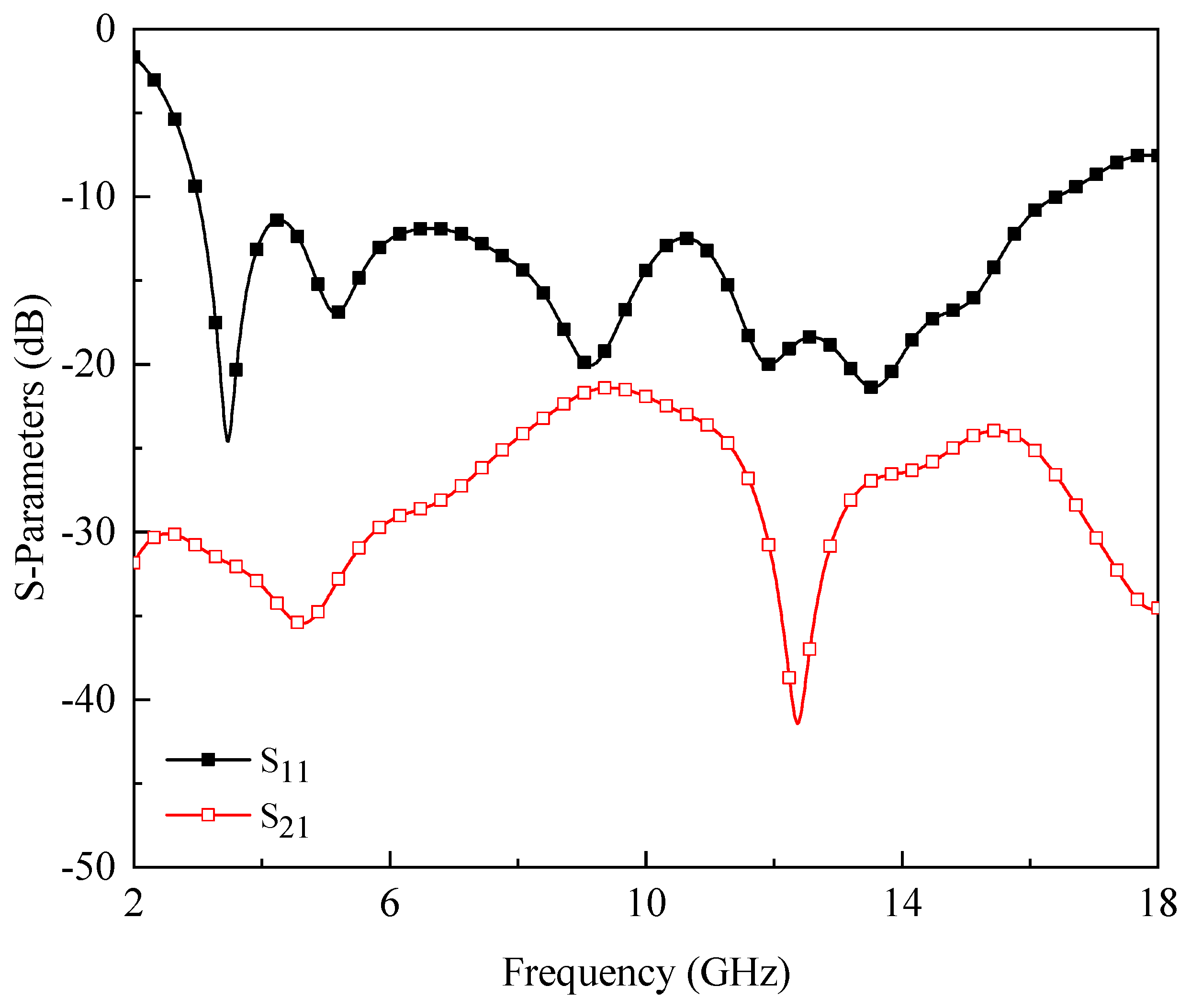
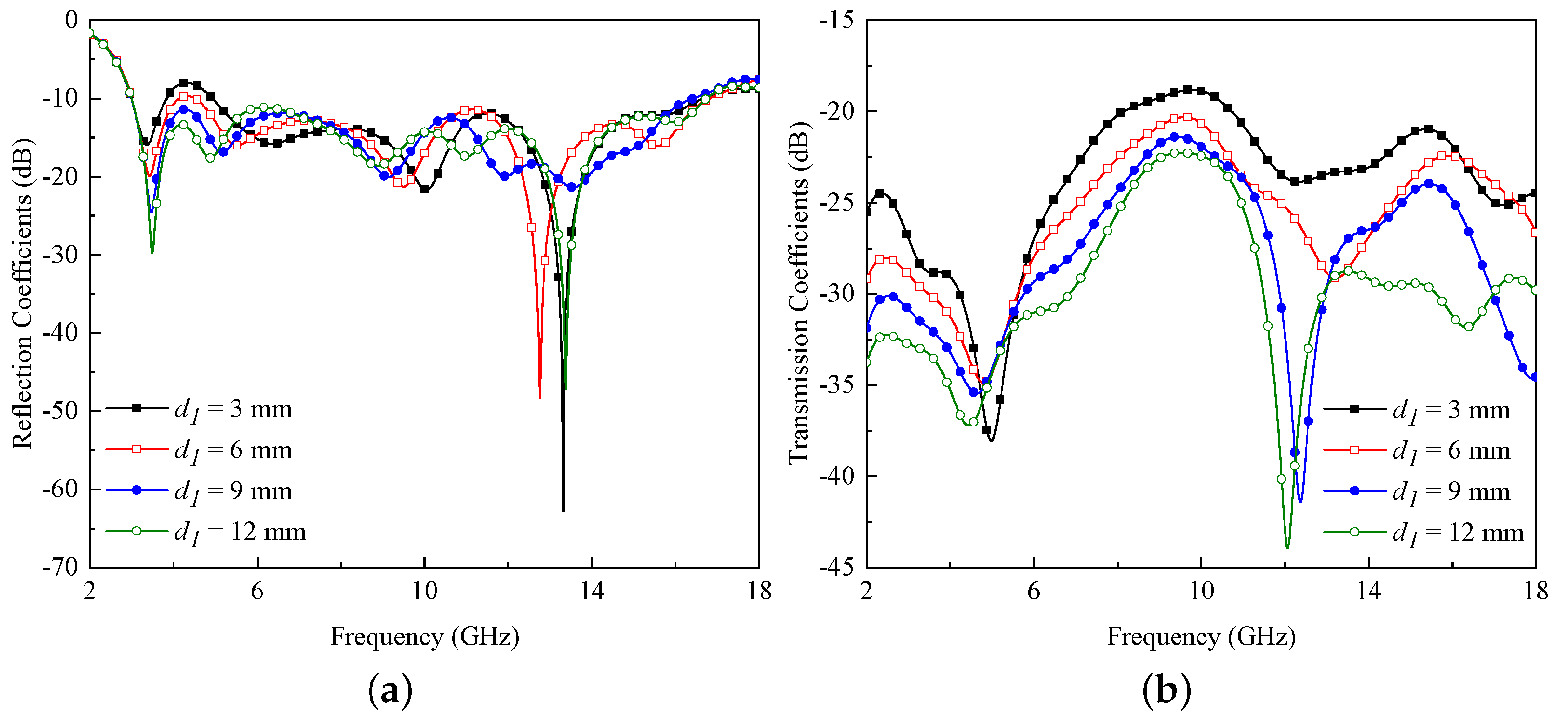
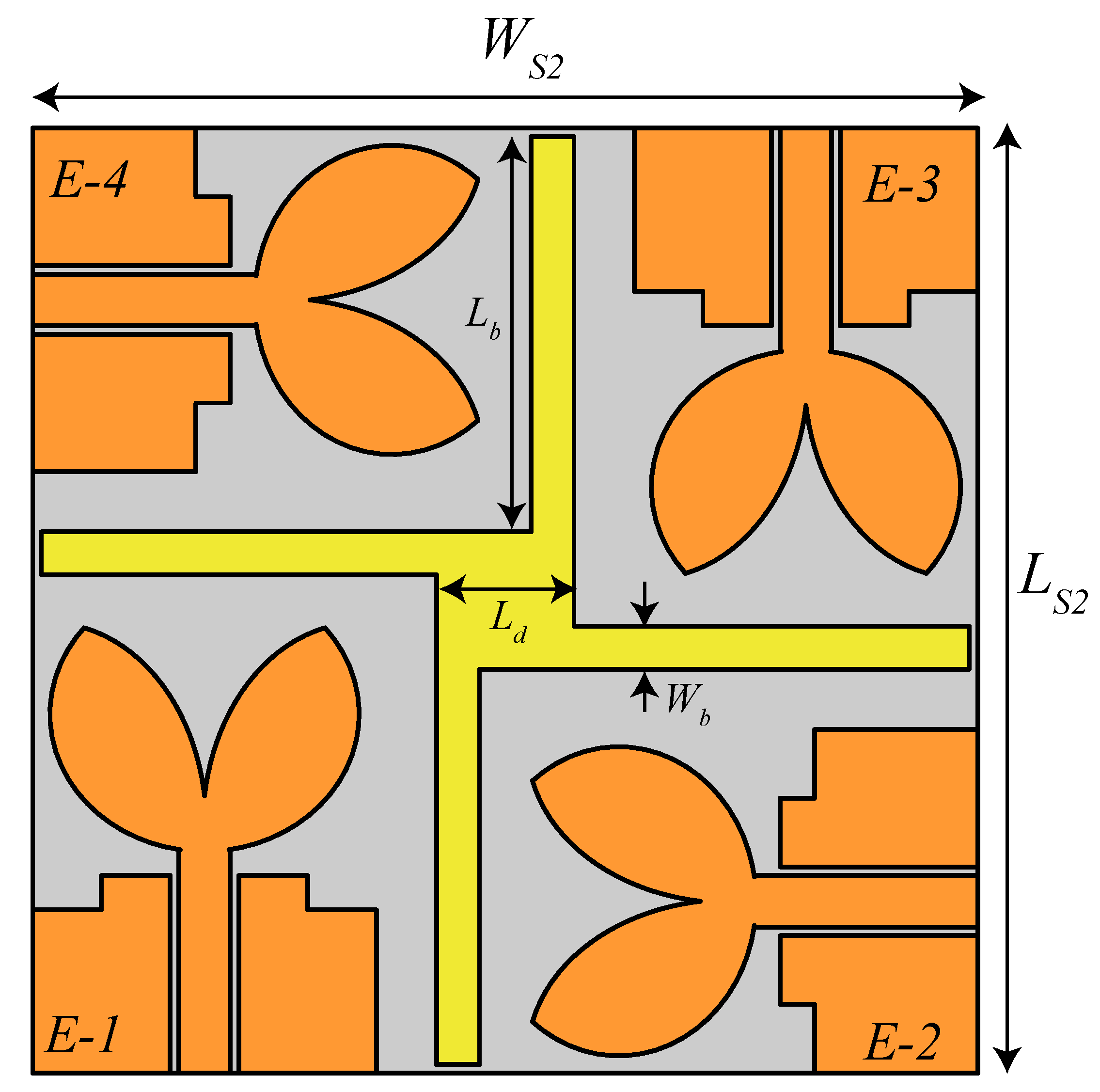
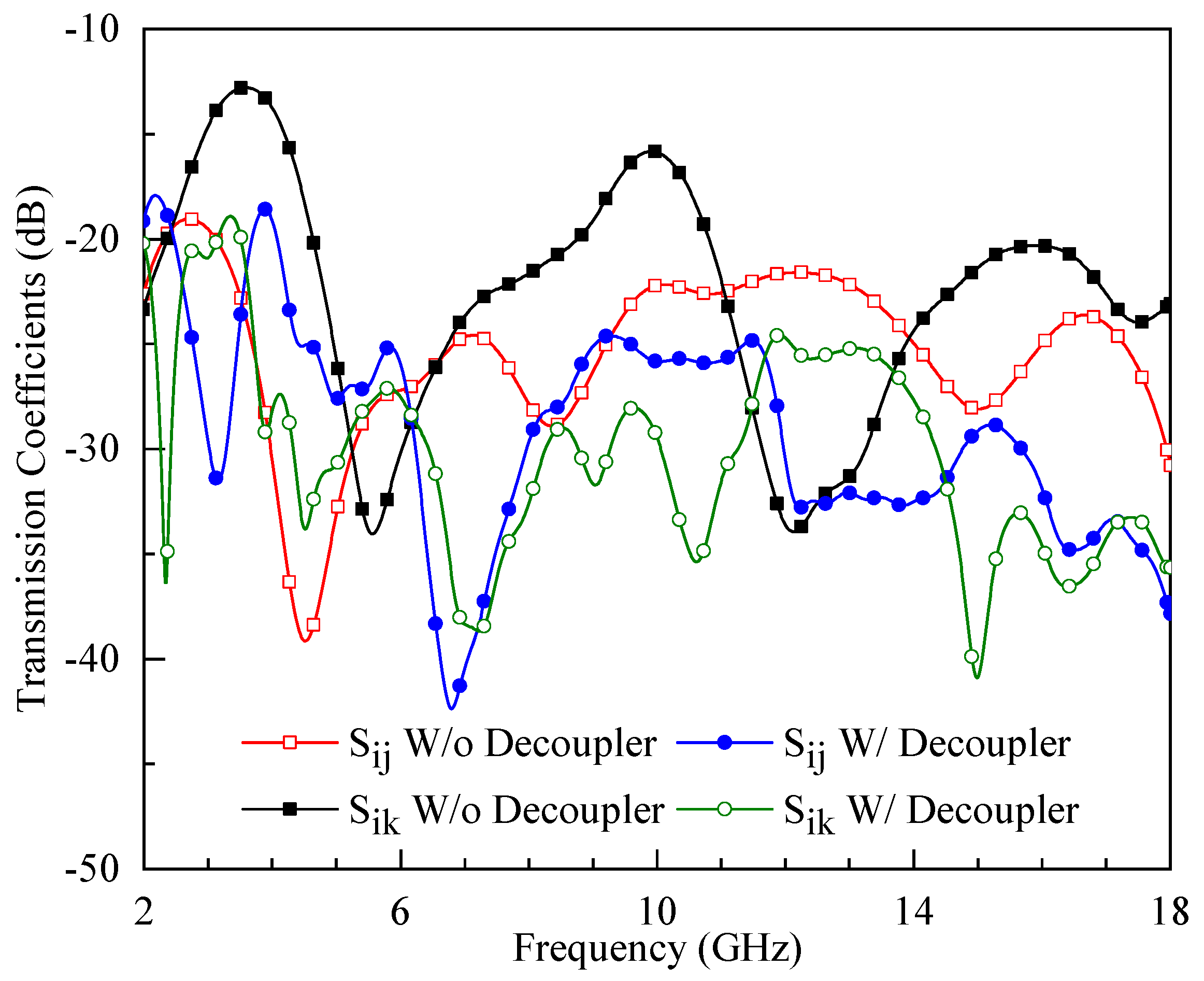
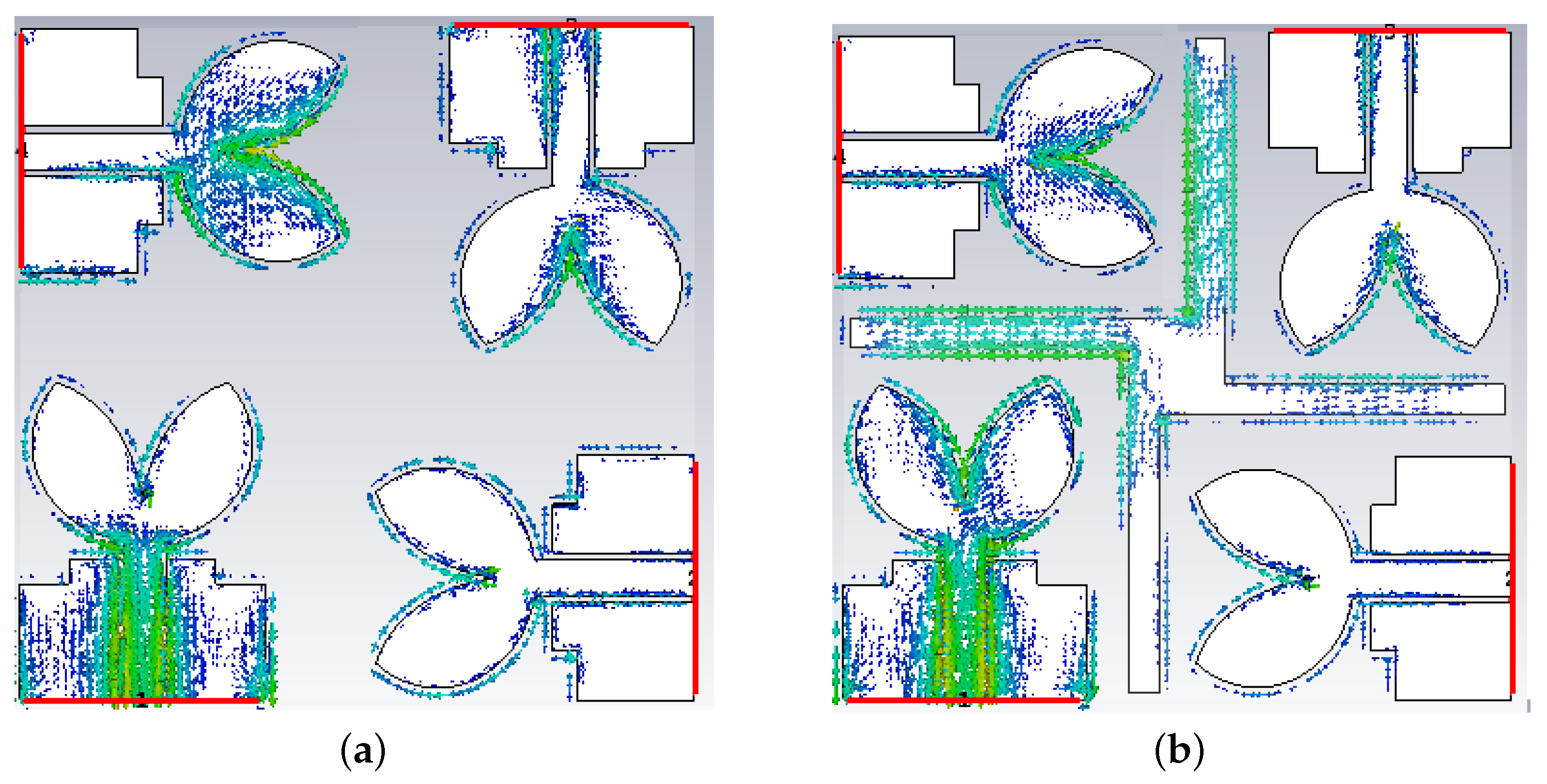

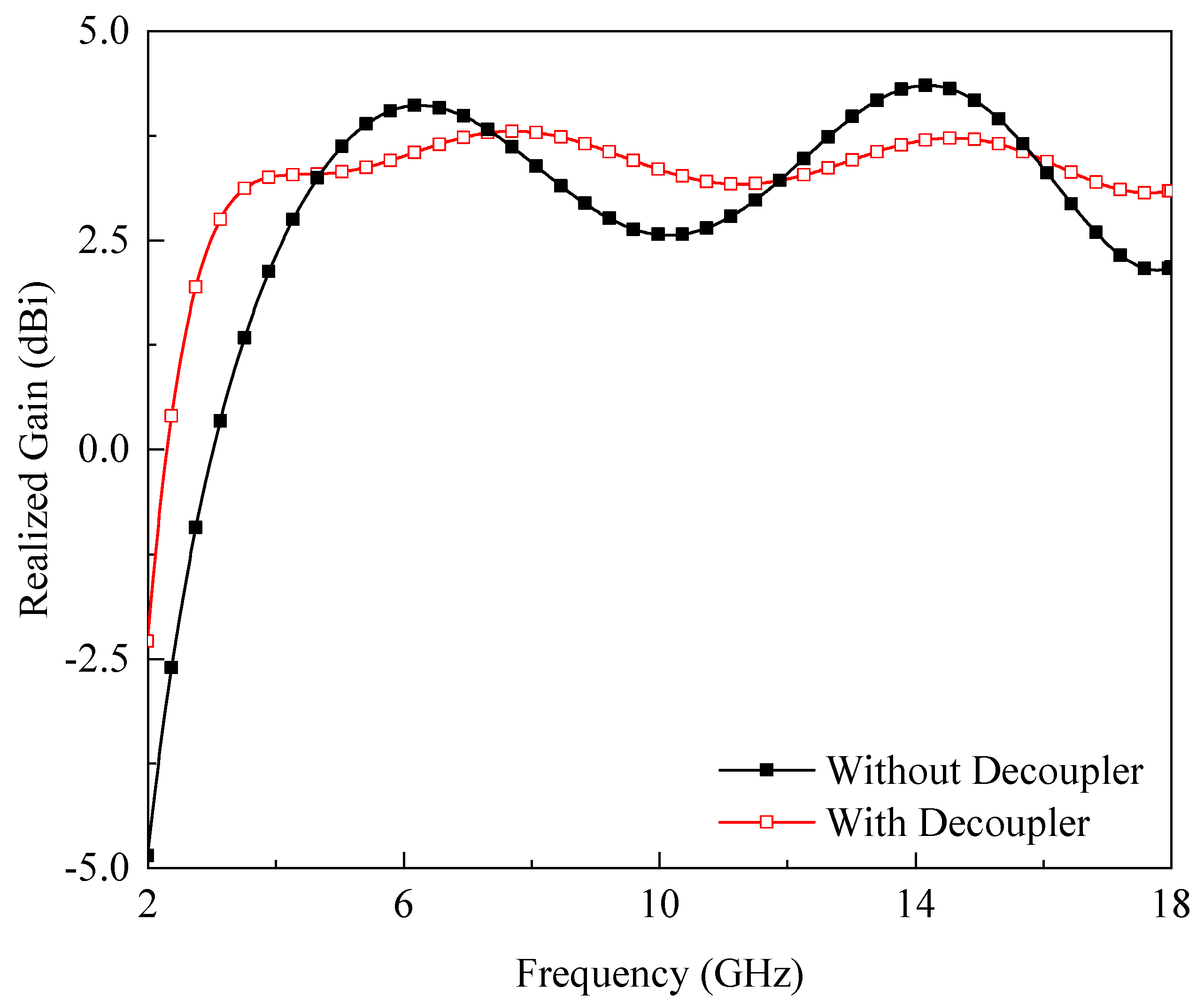
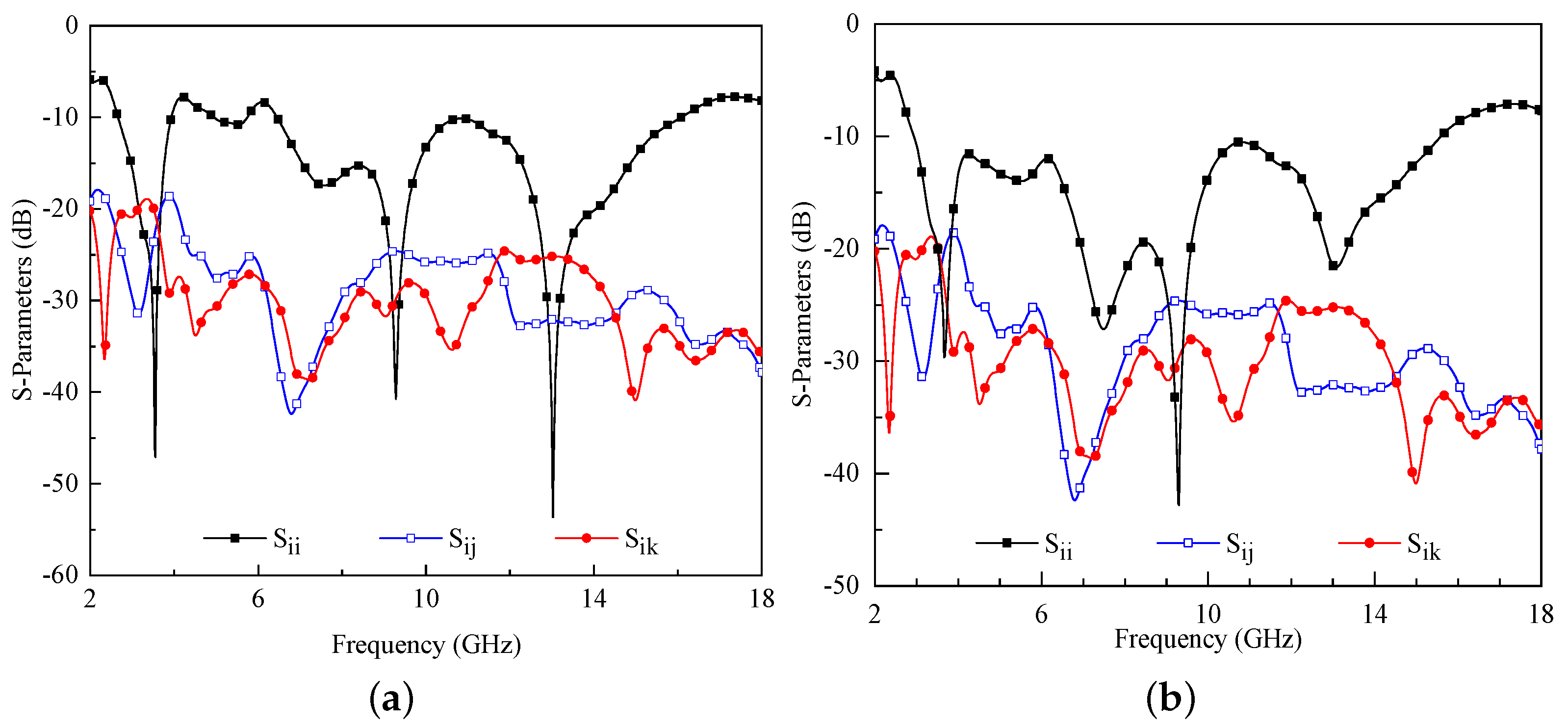
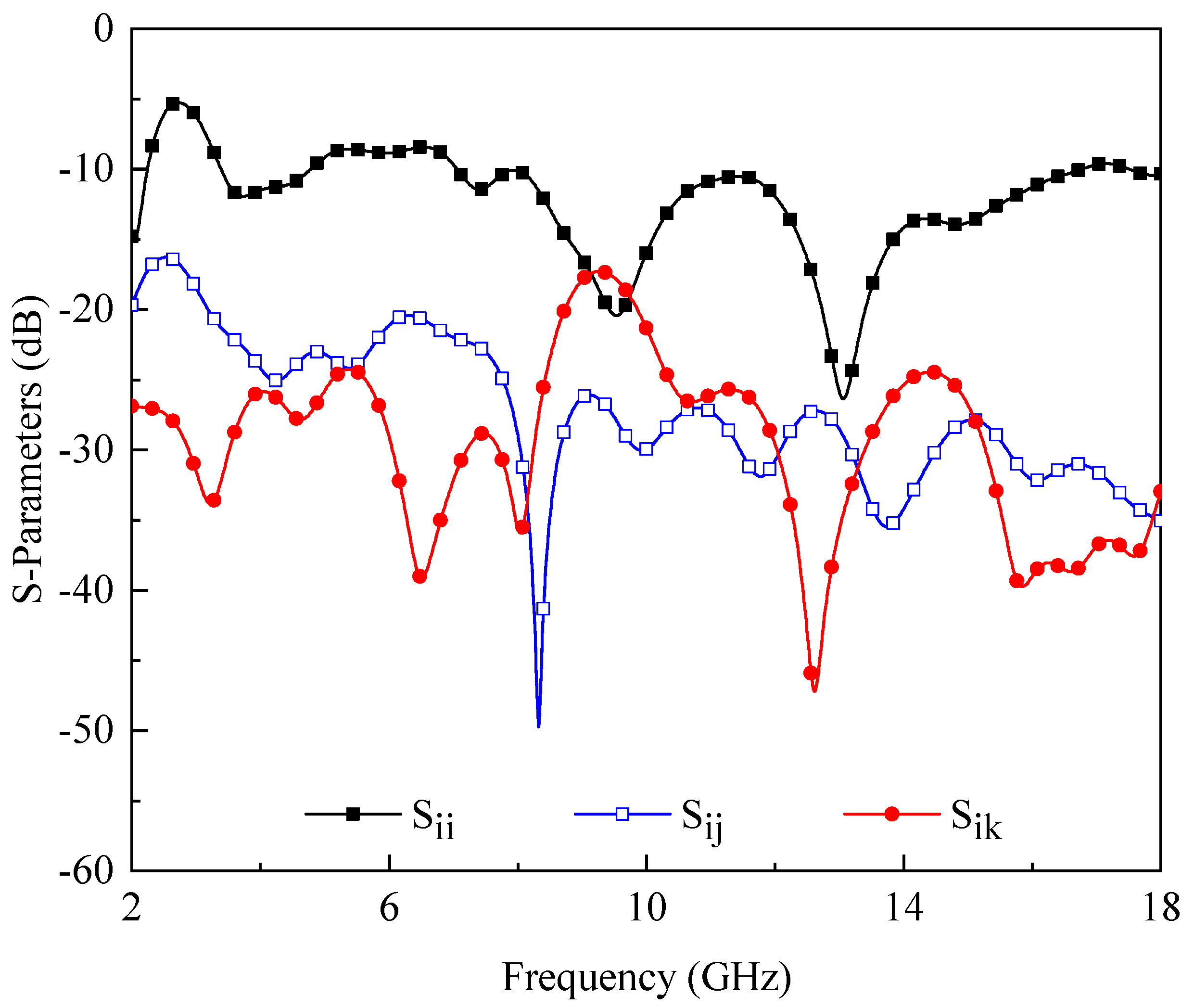
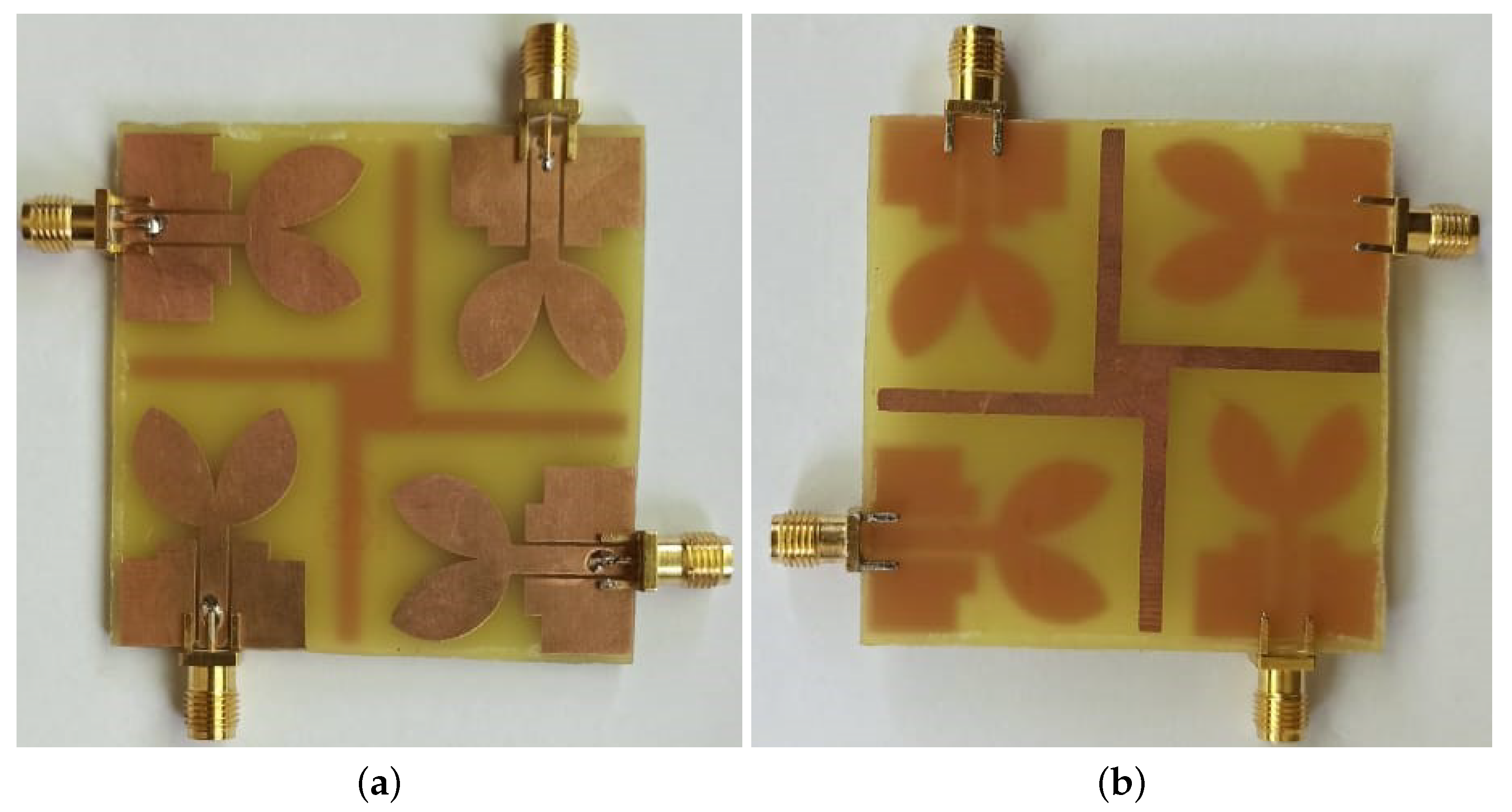
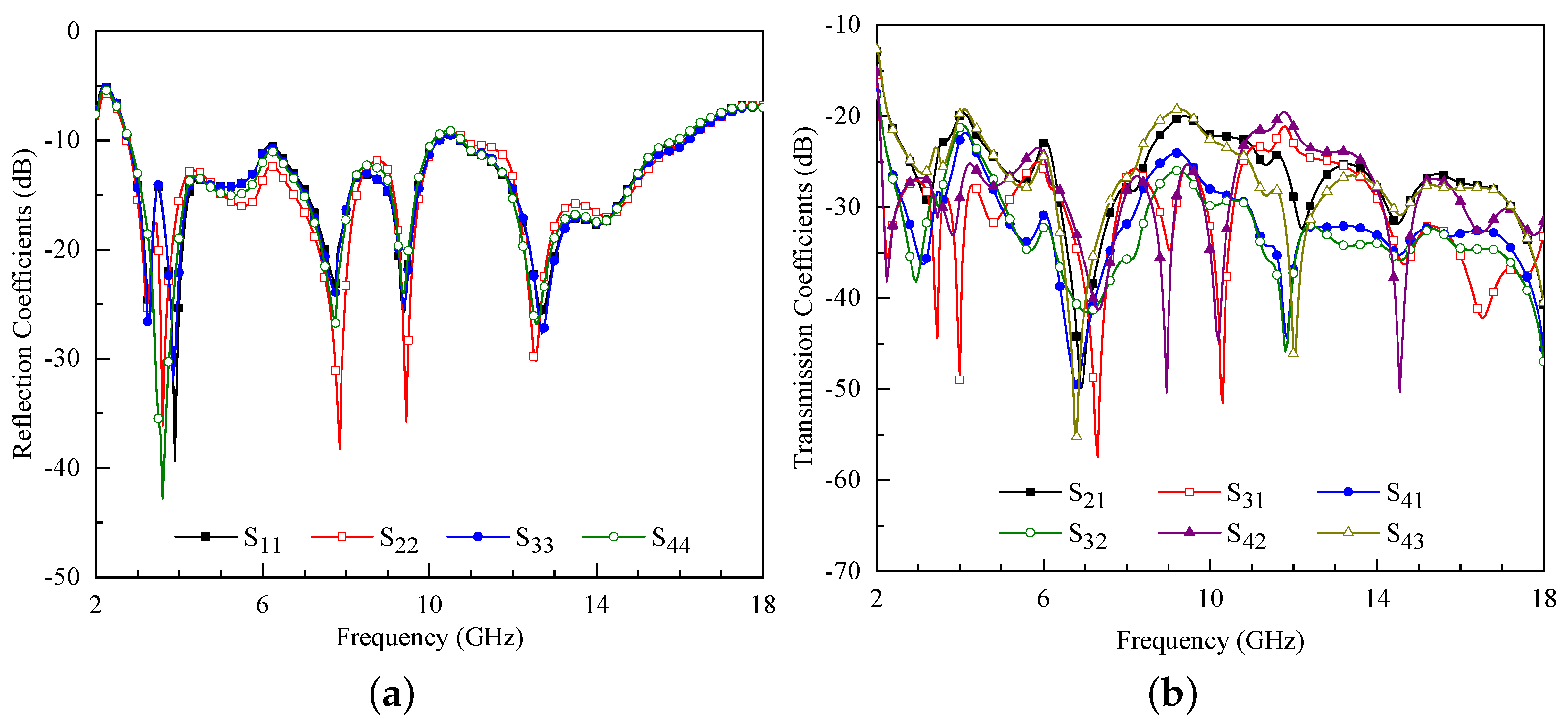
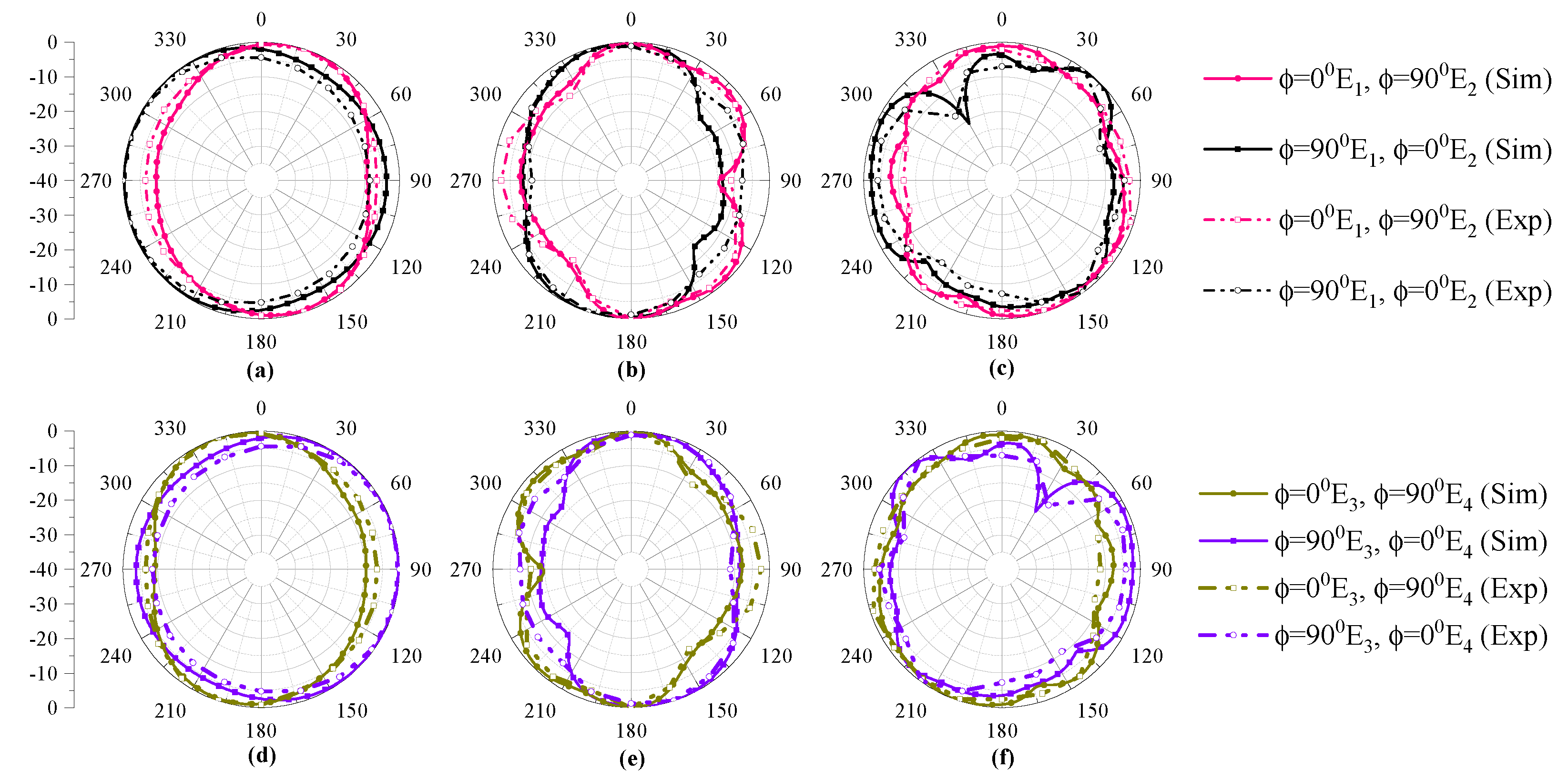
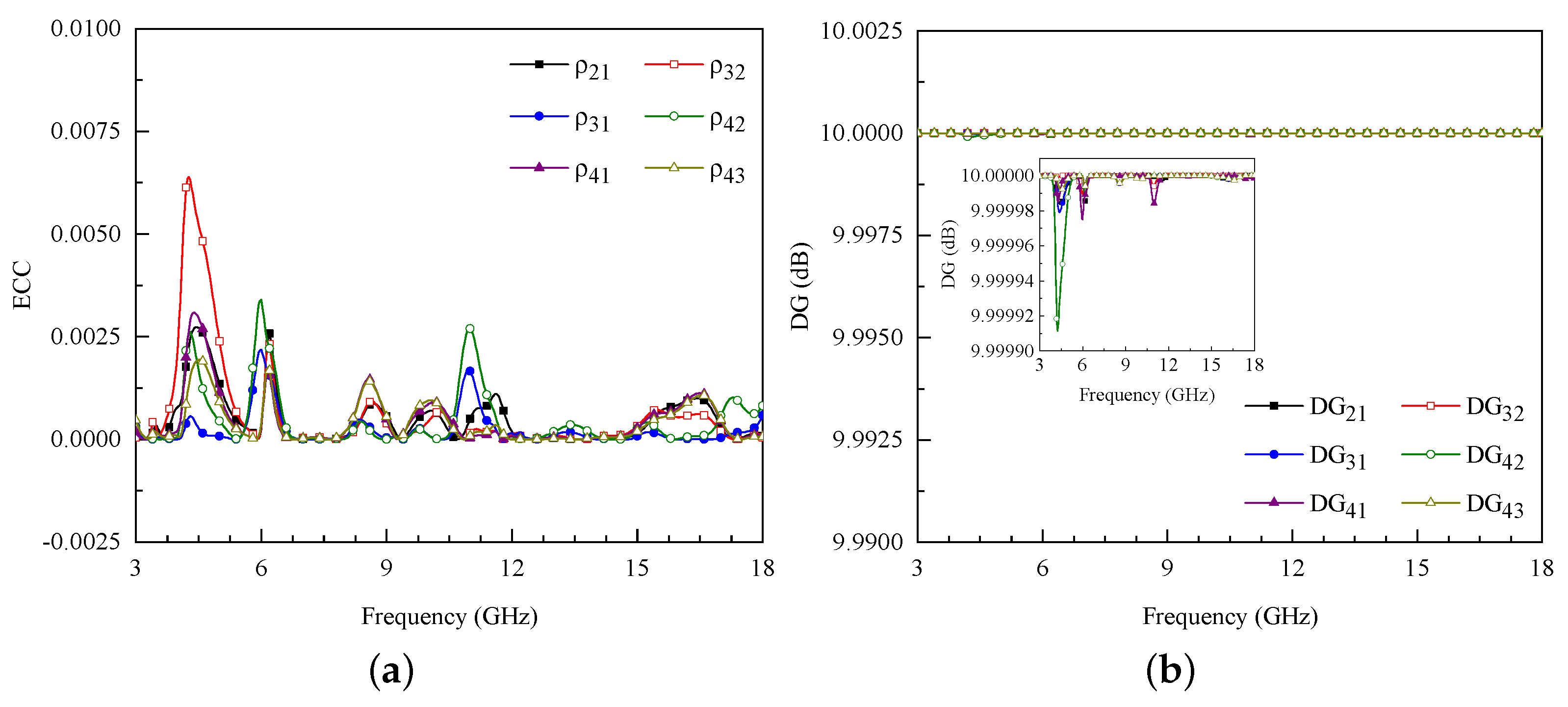
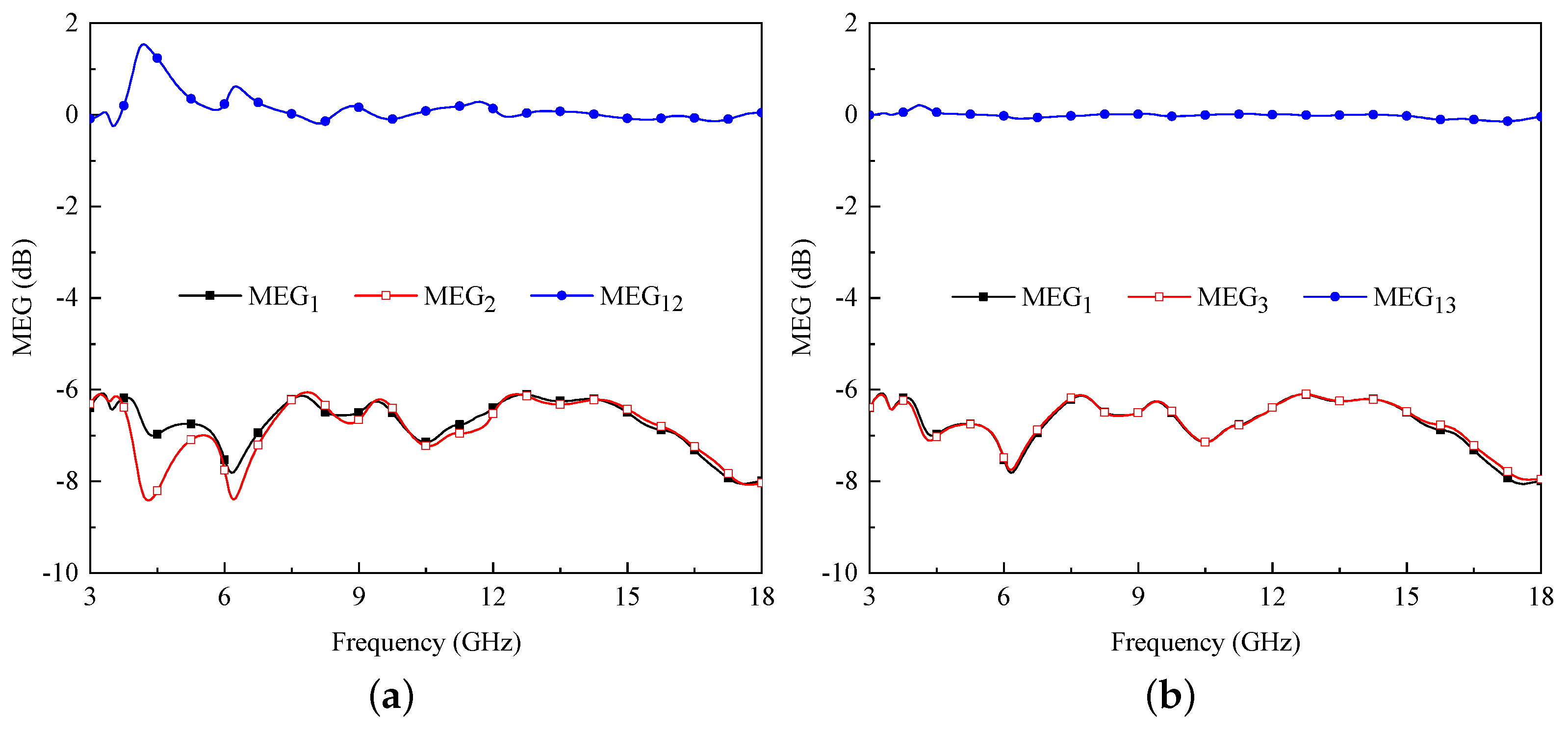
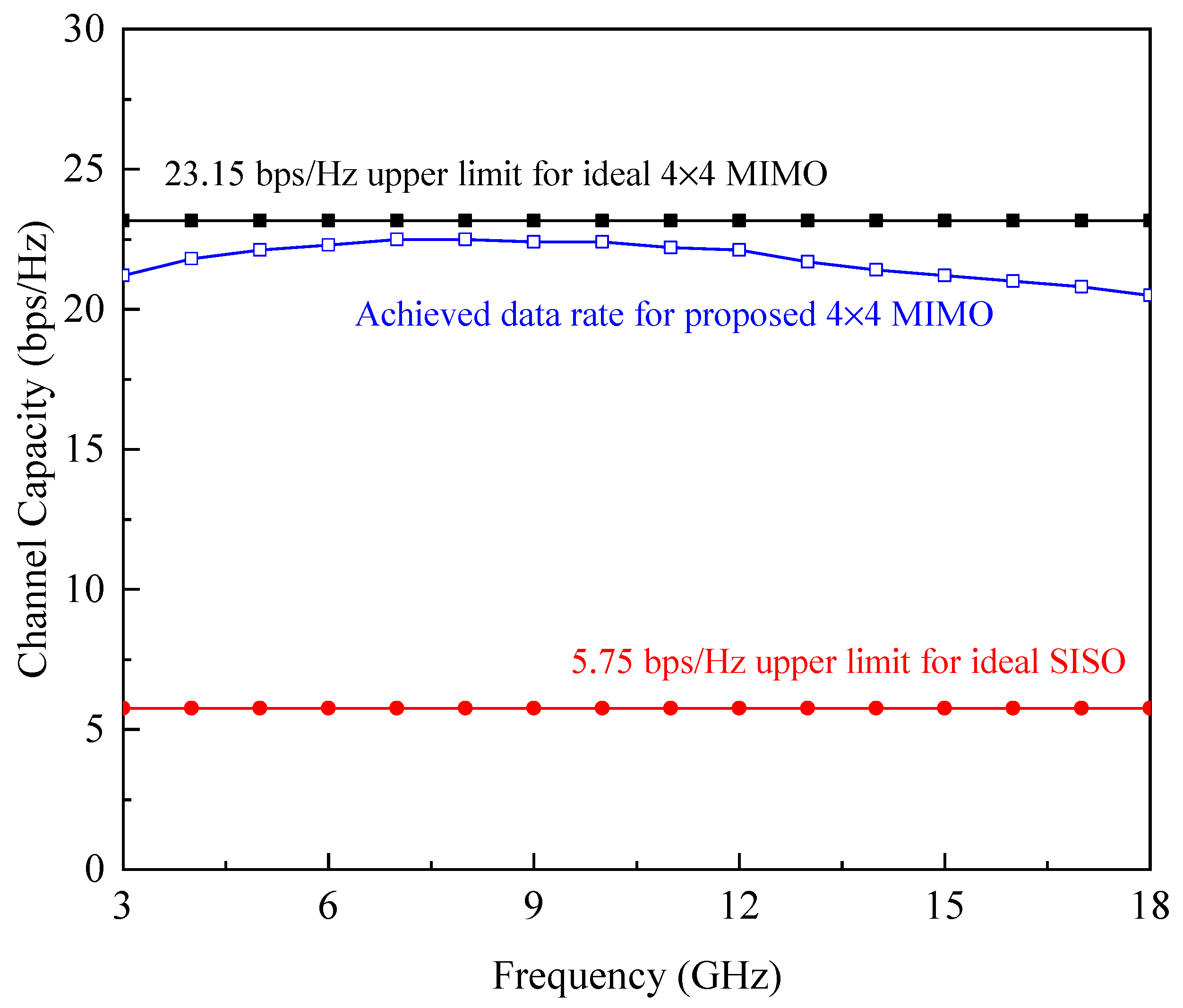
| Parameter | Value | Parameter | Value | Parameter | Value |
|---|---|---|---|---|---|
| 20 | 26 | 3 | |||
| 8 | 11.5 | g | 0.5 | ||
| 4 | 2 | t | 1.5 |
| Parameter | Value | Parameter | Value | Parameter | Value |
|---|---|---|---|---|---|
| 55 | 55 | 2.5 | |||
| 23 | 8 | – | – |
| Ref. | MIMO Size | Substrate | Bandwidth (GHz) | Isolation (dB) | ECC | DG (dB) | % Size Reduction | |
|---|---|---|---|---|---|---|---|---|
| (mm2) | (λ2) | |||||||
| [1] | 45 × 45 | 0.3 × 0.3 | FR-4 ( = 4.4) | 2–10.6 | ≥17 | <0.01 | – | – |
| [6] | 39 × 39 | 0.3 × 0.3 | FR-4 ( = 4.4) | 2.3–13.75 | ≥20 | <0.02 | >9.5 | – |
| [9] | 60 × 60 | 0.6 × 0.6 | FR-4 ( = 4.4) | 3–16.2 | ≥17.5 | <0.1 | – | 15.97 |
| [14] | 80 × 80 | 0.43 × 0.43 | FR-4 ( = 4.4) | 2.1–20 | ≥25 | <0.02 | – | 52.73 |
| [16] | 72 × 72 | 0.673 × 0.673 | FR-4 ( = 4.4) | 2.8–10.6 | ≥18 | <0.06 | – | 41.65 |
| [18] | 40 × 40 | 0.4 × 0.4 | TMM-4 ( = 4.4) | 3–10.6 | ≥15 | <0.4 | >9.95 | – |
| [19] | 80 × 80 | 0.849 × 0.849 | Taconic RF30 ( = 3) | 3.18–11.5 | ≥15 | – | – | 52.73 |
| [24] | 58 × 58 | 0.58 × 0.58 | FR-4 ( = 4.4) | 3–13.5 | ≥23 | <0.008 | 9.98 | 10 |
| This Work | 55 × 55 | 0.505 × 0.505 | FR-4 ( = 4.4) | 2.75–16.05 | ≥20 | <0.006 | ∼10 | – |
Publisher’s Note: MDPI stays neutral with regard to jurisdictional claims in published maps and institutional affiliations. |
© 2021 by the authors. Licensee MDPI, Basel, Switzerland. This article is an open access article distributed under the terms and conditions of the Creative Commons Attribution (CC BY) license (https://creativecommons.org/licenses/by/4.0/).
Share and Cite
Agarwal, S.; Rafique, U.; Ullah, R.; Ullah, S.; Khan, S.; Donelli, M. Double Overt-Leaf Shaped CPW-Fed Four Port UWB MIMO Antenna. Electronics 2021, 10, 3140. https://doi.org/10.3390/electronics10243140
Agarwal S, Rafique U, Ullah R, Ullah S, Khan S, Donelli M. Double Overt-Leaf Shaped CPW-Fed Four Port UWB MIMO Antenna. Electronics. 2021; 10(24):3140. https://doi.org/10.3390/electronics10243140
Chicago/Turabian StyleAgarwal, Shobit, Umair Rafique, Rizwan Ullah, Shakir Ullah, Salahuddin Khan, and Massimo Donelli. 2021. "Double Overt-Leaf Shaped CPW-Fed Four Port UWB MIMO Antenna" Electronics 10, no. 24: 3140. https://doi.org/10.3390/electronics10243140
APA StyleAgarwal, S., Rafique, U., Ullah, R., Ullah, S., Khan, S., & Donelli, M. (2021). Double Overt-Leaf Shaped CPW-Fed Four Port UWB MIMO Antenna. Electronics, 10(24), 3140. https://doi.org/10.3390/electronics10243140









